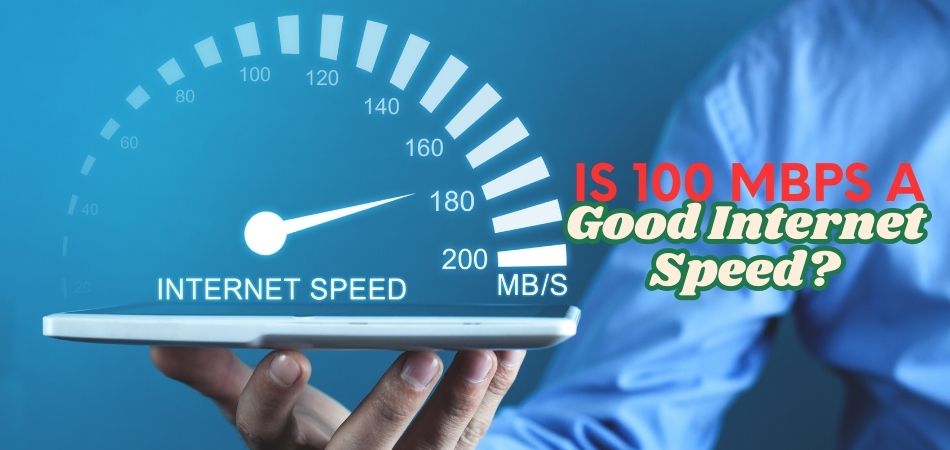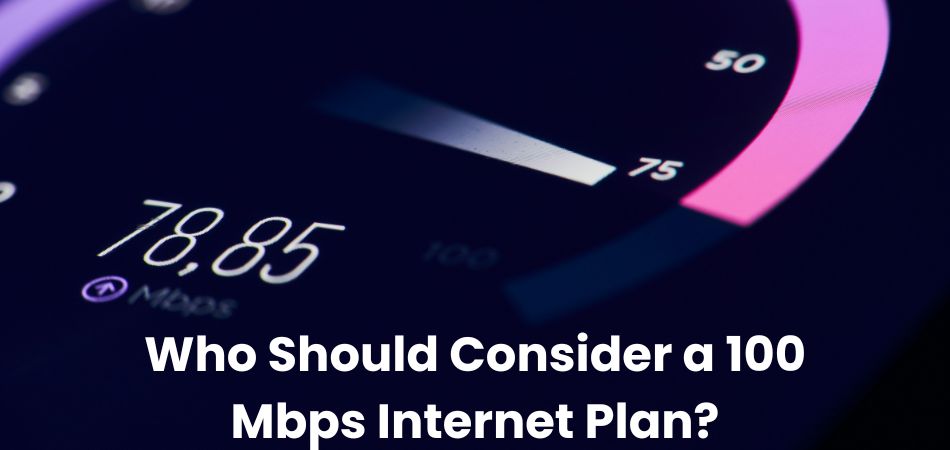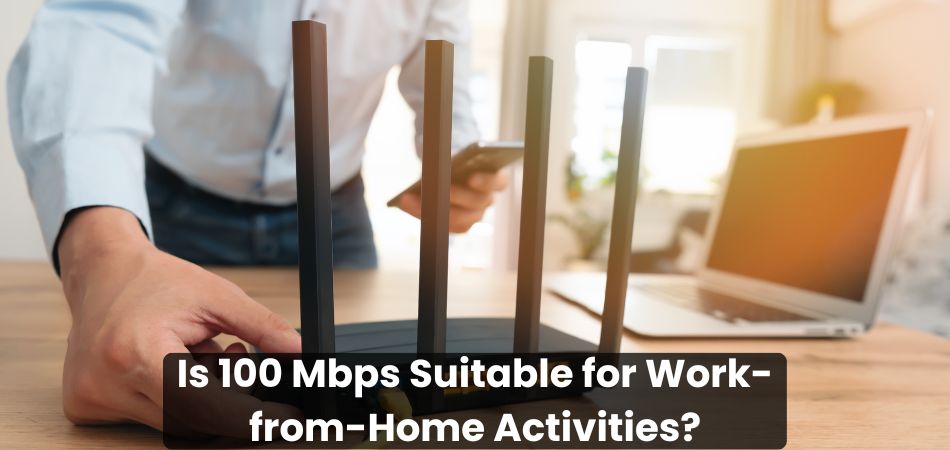Having a reliable internet connection is essential for work, streaming, gaming, and staying connected. With various speed options available, choosing the right plan can be confusing.
Many users wonder if their current internet speed meets their needs. So, is 100 Mbps a good internet speed for your daily online activities?
Yes, 100 Mbps is a good internet speed for streaming, online gaming, remote work, and browsing on multiple devices. However, larger households or heavy users may need faster speeds for optimal performance.
Curious to know if this speed matches your lifestyle? Keep reading to know how 100 Mbps performs and whether it’s the best fit for your internet demands.
Is 100 Mbps a Good Internet Speed? Pros and Cons Explained
Choosing the right internet speed can be challenging, especially with so many options available. Many people ask, is 100 Mbps a good internet speed for their online needs? The answer depends on how you use the internet, how many devices are connected, and the type of activities you engage in daily.

For moderate households, 100 Mbps offers a balance between performance and cost. It can easily handle streaming HD videos, online gaming, and video conferencing for a few users simultaneously. However, for larger households or heavy internet users, this speed might not always be sufficient.
Knowing the pros and cons of a 100 Mbps connection can help you decide if it’s the right choice. Below is a breakdown of its advantages and disadvantages:
Pros of 100 Mbps Internet Speed:
- Smooth HD Streaming: Stream high-definition videos on platforms like Netflix and YouTube without buffering issues. It supports multiple streams simultaneously.
- Reliable for Remote Work: Offers stable video conferencing and file transfers, making it ideal for remote workers.
- Online Gaming-Friendly: Provides low latency and smooth gameplay for casual to moderate online gaming.
- Supports Multiple Devices: Can handle several connected devices without a significant drop in performance.
- Faster Downloads: Downloads large files, software updates, and media content quickly.
- Cost-Effective: More affordable than higher-tier plans while still offering solid performance.
- Easy Smart Home Integration: Efficiently supports smart devices like cameras, speakers, and thermostats.
Cons of 100 Mbps Internet Speed:
- Limited for Large Households: May struggle when many devices are streaming or gaming simultaneously.
- Not Ideal for 4K Streaming: High-resolution 4K streaming on multiple devices could cause buffering.
- Slow for Heavy Upload Tasks: Upload speeds are often lower, which can hinder cloud backups and large file sharing.
- Future-Proofing Concerns: As technology advances, 100 Mbps may not meet future demands for higher bandwidth activities.
How Many Devices Can Connect at 100 Mbps?
A 100 Mbps internet connection can comfortably support multiple devices, but the exact number depends on how each device uses the internet. For basic activities like browsing, checking emails, and social media, this speed can easily handle 10 to 15 devices without noticeable slowdowns. However, when devices are streaming HD videos, gaming online, or downloading large files, the capacity decreases.
For households with moderate internet use, 100 Mbps is typically enough for 4 to 6 devices engaging in more demanding tasks like HD streaming or online gaming. If multiple devices are streaming in 4K or involved in high-bandwidth activities like video conferencing and large file uploads, the network may become congested, causing slower speeds and buffering.
To maximize performance, you have to balance device usage and internet demand. Smart devices, background updates, and cloud backups can silently consume bandwidth. Managing these connections ensures that a 100 Mbps plan runs smoothly, delivering a seamless online experience for all users.
Difference Between Upload and Download Speeds of 100 Mbps
When discussing internet speeds, knowing the difference between upload and download speeds is crucial. Download speed refers to how quickly data is received from the internet, while upload speed indicates how fast data is sent from your device to the internet. Below is a table comparing the two for a 100 Mbps connection:
| Aspect | Download Speed (100 Mbps) | Upload Speed (Typically 10–20 Mbps) |
| Definition | Speed at which data is retrieved from the internet | Speed at which data is sent to the internet |
| Examples of Use | Streaming videos, browsing, downloading files | Video calls, uploading files, cloud backups |
| Impact on Activities | Faster streaming and file downloads | Slower large file uploads and cloud backups |
| Typical Ratios | High speed (100 Mbps) for downloads | Lower speed (usually 10–20% of download) |
| Best Suited For | General online use, entertainment | Professionals needing to upload large files |
| Limitations | None for most users | Can hinder heavy upload tasks or backups |
Who Should Consider a 100 Mbps Internet Plan?
A 100 Mbps internet plan offers a solid balance between speed and affordability, making it suitable for many users. It can efficiently handle daily online tasks, moderate streaming, and casual gaming. Here are some types of users who would benefit from a 100 Mbps internet plan:

- Small families with devices
- Remote workers and freelancers
- Casual online gamers
- HD video streaming households
- Social media content creators
- Students attending online classes
- Smart home device users
- Moderate file downloaders
- Online shoppers and browsers
- Light video conferencing users
- Podcast listeners and creators
- Bloggers and digital writers
- Small business home offices
- Fitness enthusiasts streaming workouts
- Music streaming subscribers
- Occasional 4K content watchers
- Cloud storage users (light)
- Social media managers
- Light graphic design users
- Virtual event attendees
Factors That Impact Your 100 Mbps Internet Performance
While a 100 Mbps connection is generally sufficient for many users, several factors can affect its overall performance. Knowing these influences can help you optimize your internet experience and avoid unexpected slowdowns. Below are key factors that can impact how well your 100 Mbps internet performs:
Network Congestion During Peak Hours
Internet speeds often drop during peak usage times when many users are online. This typically happens in the evenings or weekends when households stream content or game online. Shared networks in apartments or crowded neighborhoods can worsen this slowdown. As demand increases, your 100 Mbps speed may feel much slower.
Router Placement and Quality
The position and quality of your router significantly affect internet performance. Placing the router in a central, upgrade area improves signal coverage. Outdated or low-quality routers may not fully support 100 Mbps speeds. Upgrading to a modern, dual-band router can enhance connectivity.
Wired vs. Wireless Connections
Devices connected via Ethernet cables usually experience faster, more stable speeds than those on Wi-Fi. Wireless connections can suffer from interference and signal drops. Walls, floors, and other obstacles can weaken the Wi-Fi signal. Using wired connections for high-bandwidth tasks ensures optimal performance.
Background Applications and Updates
Many devices run background apps and automatic updates that quietly consume bandwidth. Cloud syncing, software updates, and background streaming can slow down internet speeds. Managing these tasks and scheduling updates during off-peak times can help. Disabling unnecessary background apps improves overall internet performance.
Internet Service Provider (ISP) Throttling
Some ISPs intentionally slow down speeds after users reach data limits or during high-traffic periods. This practice, called throttling, can significantly impact performance without notice. Reviewing your service agreement and monitoring data usage can help identify throttling. Upgrading to a plan without data caps can prevent speed reductions.
Is 100 Mbps Suitable for Work-from-Home Activities?
Working from home demands a stable and efficient internet connection to handle various tasks. A 100 Mbps internet plan can support most remote work activities, but certain factors influence its effectiveness. Here’s a detailed look at how 100 Mbps performs for different work-from-home needs:

Video Conferencing Stability
Video calls require consistent bandwidth to prevent lag and disruptions. Platforms like Zoom and Microsoft Teams typically need 3-5 Mbps for HD calls. A 100 Mbps plan can handle multiple video calls simultaneously without dropping quality. However, background devices streaming or downloading may cause slight interruptions.
Large File Downloads and Uploads
Downloading large files is smooth with 100 Mbps, but uploading can be slower due to lower upload speeds. Creative professionals handling videos or large datasets might experience delays. Cloud backups and file sharing could take longer. A higher upload speed plan may be more efficient for heavy tasks.
Virtual Private Network (VPN) Usage
VPNs secure data but can reduce internet speed due to encryption. A 100 Mbps plan typically manages VPN use well for secure browsing and work platforms. However, performance may drop when running data-heavy applications through a VPN. Choosing a high-speed VPN server can help maintain efficiency.
Multiple Connected Devices
Remote workers often use multiple devices—laptops, smartphones, and smart home gadgets. A 100 Mbps plan supports several devices with light to moderate use. However, simultaneous high-bandwidth activities like streaming or large downloads may slow performance. Prioritizing work devices on the network can improve reliability.
Cloud-Based Applications and Tools
Cloud services like Google Workspace and Microsoft 365 require steady internet for real-time collaboration. A 100 Mbps connection supports these tools for document sharing and editing without lag. Problems may arise if large files or complex applications run concurrently. Managing active cloud services can prevent slowdowns.
Remote Desktop Access
Remote desktop software allows seamless access to office systems from home. 100 Mbps speeds ensure responsive navigation and file access. Issues may occur if other household members use bandwidth for streaming or gaming. Dedicated bandwidth for remote access can improve performance.
Online Training and Webinars
Participating in webinars and online training often involves video streaming and interactive tools. A 100 Mbps connection easily supports high-definition video streams and real-time interaction. Delays might occur if background devices are heavily using bandwidth. Closing non-essential applications during webinars can optimize performance.
Frequently Asked Questions About 100 Mbps Internet Speed
Finding out how a 100 Mbps internet plan works can help you decide if it’s the right fit for your needs. Here are some common questions and detailed answers to help you make an informed decision.
1. Can 100 Mbps Support Online Learning for Multiple Students?
Yes, 100 Mbps can support online learning for multiple students in a household. Video classes, research, and interactive tools typically require moderate bandwidth. However, simultaneous video streaming or gaming may slow performance during peak usage times.
2. Is 100 Mbps Enough for Running a Small Business?
A 100 Mbps connection is suitable for small businesses with basic internet needs. It handles email, web browsing, cloud-based apps, and occasional video conferencing well. However, businesses requiring frequent large file transfers or server hosting might need higher speeds.
3. How Does 100 Mbps Perform for Smart Home Devices?
100 Mbps can efficiently support smart home devices like security cameras, smart thermostats, and voice assistants. These devices generally use minimal bandwidth for regular operations. However, multiple high-definition security cameras streaming simultaneously may strain the connection.
4. Will 100 Mbps Be Fast Enough for Future Internet Demands?
While 100 Mbps is sufficient for most current online activities, future technologies may demand faster speeds. Increasing 4K/8K streaming, virtual reality, and smart devices could require more bandwidth. Upgrading to higher speeds might become necessary as digital needs grow.
5. Does 100 Mbps Guarantee Consistent Speeds?
No, 100 Mbps does not always guarantee consistent speeds due to factors like network congestion, router performance, and ISP limitations. Real-world speeds can fluctuate depending on the time of day and device usage. Regularly maintaining your network can help improve consistency.
Final Words
How fast the internet is for your family depends on how much time you spend online and how many devices you have connected. For moderate users, 100 Mbps offers a balance between affordability and performance, supporting streaming, online gaming, and remote work.
However, larger households or heavy internet users might need faster speeds to avoid slowdowns. So, is 100 Mbps a good internet speed for your needs?
It’s ideal for small to mid-sized families and users with standard online demands. If your activities involve high-bandwidth tasks like 4K streaming or large file uploads, consider upgrading. Assess your usage to make the best decision.
